“A Canadian artist just ripped off Pinay artist Gel Jamlang’s work,” read the title of a news article published in Manila Coconuts on November 17, 2014. My interest was more than piqued, as artist Gel Jamlang is not only someone whose work I admire; she is also a friend.
I first met Gel in 2009, when I was assigned to write a feature piece about her and her mother, Cynthia Bustos, for a local lifestyle magazine. Mother and daughter were, in those days, the dynamic duo behind a venture simply called “Pueblo”; a home-design company with no shortage of artistic ideas for every living space.
Even back then, Gel was already quite a prolific painter; having already been commissioned by numerous people for pieces, large and small, executed on just about anything and everything – from walls, hall, and bathrooms, to furniture and canvas, for instance. I had a chance to view some of her impressive, eye-catching pieces, which hung in strategic spots around the Artist’s Gallery, the Jamlang residence-cum-atelier and studio showroom. Aside from paintings on display, others – in various states of completion – lined the hallways of her studio. Gel’s large murals – painted on rounded, pueblo-inspired facades – alluded to the style of American artist, Georgia O’ Keefe.
I was, as I so vividly recall, blown away by Gel’s sheer artistry and unique concept of beauty. Not surprising, as she hails from a family of creative souls (aside from her mother’s own keen eye for art, her father, Eliezer, is a painter, as well.)
Since then, Gel – who is now based in Maryland, U.S.A. – has grown into her own riveting style of expression, and many have taken notice. The artist has developed quite a following for her work, which is provocative and evocative, all at once. Much of it is a brilliant juxtaposition of dark imagery rendered in cool, soothing colours.
One person – Ontario-based “artist,” Kayli Coates – took notice, as well. One person with motives much darker than Gel’s visual symbolisms.
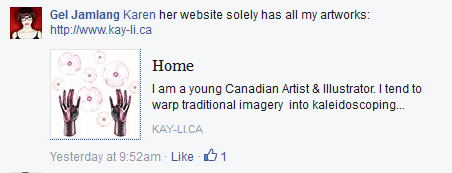
Message from a stranger
“Some stranger emailed me. Initial reactions? Alarm!,” Gel said to me via quick private chat on Facebook, when I asked her how she was alerted to what Kayli Coates had done.
You see, Ms. Coates had done the unspeakable, as far as artists and creative types are concerned: She had passed-off Gel’s artwork as her own. She had committed the “P-word” we dare not mention in polite society. She had plagiarized. Ripped-off Gel’s work, as the Coconuts blurb decried.
What’s worse, she had done so for another “P-word”: Profit.
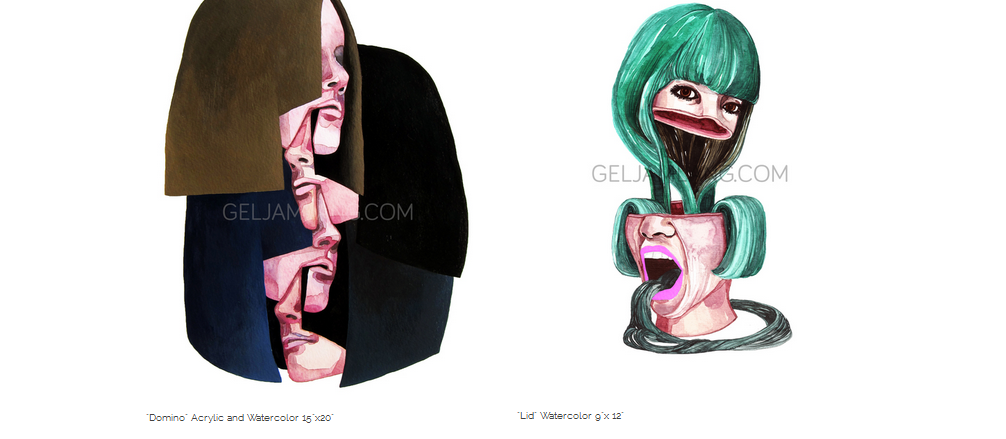
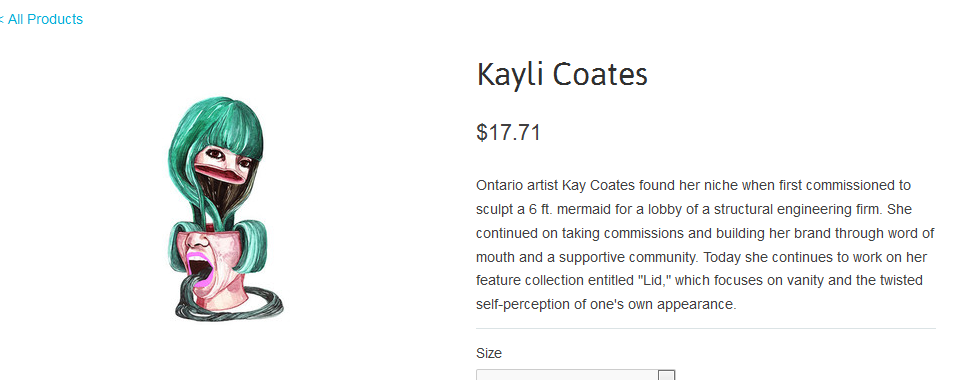
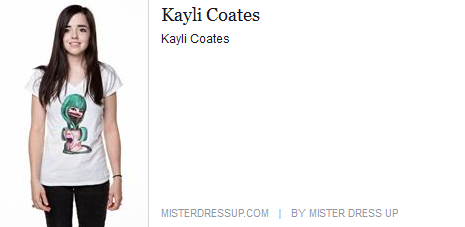
Not only had Coates – who on her Google Circles profile claims to be a commissioned artist – filled her own website with pieces of Gel’s art under false claims of these being her own; she also printed Gel’s image (entitled “Lid”) on T-shirts sold on online store, Mister Dress Up. If you followed that last link, you would have received a “404 Page Not Found” error message where Coates’ fraudulent designs and products used to be (not to fret, we took screen shots). Of course, Mister Dress-Up has taken Coates’ stuff down, due to an uproar from Gel’s friends. But I’m getting ahead of myself.

An army of advocates
In her initial alarm, Gel recalled fretting about how to take the shameless copycat down. She also quickly realized that an army of intellectual property rights advocates, who also happened to be her friends, had her back.
“I was like, ‘this b*itch; now I have go do something…’BUT MAN. Thanks to friends, the only thing up and running is that t-shirt!”, Gel said.
Self-described (and rightfully so) “Internationally Renowned T-Shirt Police”, Karen Kunawicz (of the recent SM Rape Shirt exposé / viral phenomenon, sounded the alarm once more via social media. She also emailed several of us, whom she knew would act, in our own ways. Feanne Hontiveros – indie singer, songwriter and visual artist who has, in past, also been victimized by a plagiarist – was the first to email the Mister Dress-Up team. Some of us followed suit; other sent messages on Facebook or Twitter. Anything to elicit action against Coates and her despicable deed.
In a matter of hours, Coates had taken down her website, Instagram, and Twitter accounts. Her boyfriend, on the other hand, set all his profiles to private. The reactions of the guilty, in this cyber-age, are oh-so predictable.
It took a while longer for Mister Dress-Up to act; but action did come towards the end of the day, by way of taking down Coates’ merchandise from their site. Did they, however, offer some form of apology; some form of remuneration? Not that we know of. In their response to Feanne’s email, all that Mister Dress-Up founder Samuel Charrios said was (unedited): “yes its been taken care of thanks”.
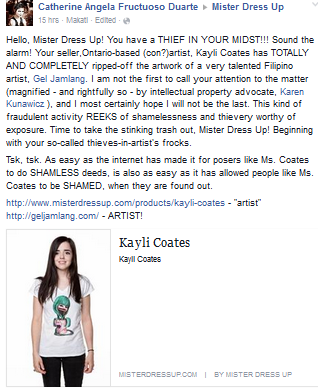
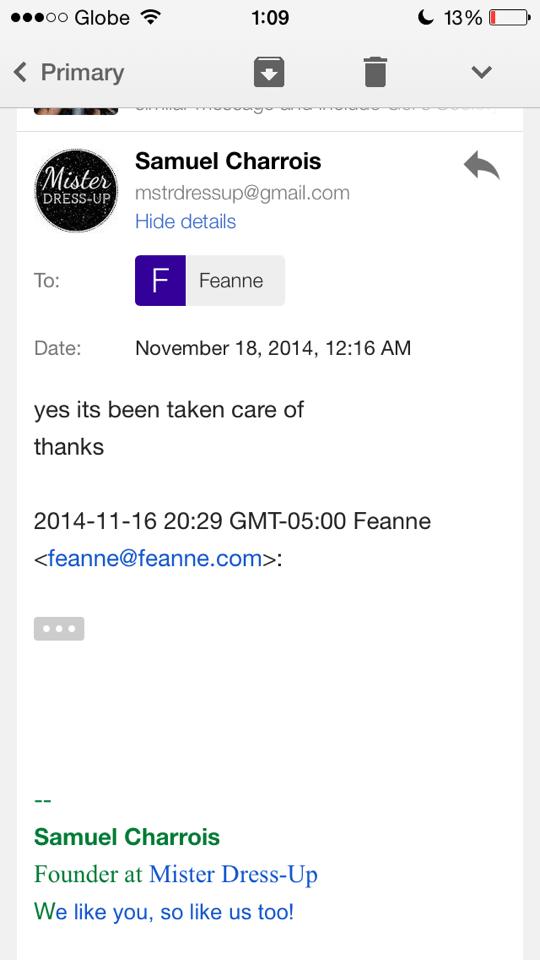
When copycatting is criminal
Coates’ actions cannot and should not be taken lightly. Thankfully, the shirt with the stolen design was taken off the shopping site. But that is probably the least that Charrios and his team could have and should have done.
Plagiarism is a CRIME, which violates copyright laws, which have been set in place to protect intellectual and creative property.
The U.S.-based organization, Plagiarism.org, provides a basic definition of the crime:
“Simply put, plagiarism is the use of another’s original words or ideas as though they were your own. Any time you borrow from an original source and do not give proper credit, you have committed plagiarism and violated U.S. copyright laws.”
“At one time, a work was only protected by copyright if it included a copyright trademark (the © symbol). According to laws established in 1989, however, works are now copyright protected with or without the inclusion of this symbol,” it emphasizes; providing us helpful insight into the inner workings of these laws.”
However, the group also points out that plagiarism “in the information age is not always a cut and dry issue.” Copyright laws are evolving, but perhaps not as quickly as creative domain is.
The site likewise lists the intricacies of the law, and how it applies within the U.S., as well as academic and legal ramifications (which may involve hefty fines, and even jail time.)
Indeed, the Age of the Internet has made it very easy for unscrupulous individuals to commit SHAMELESS acts; such as Coates did. However, by the same token, it has also become very easy for people like Coates to be SHAMED online for their wrongful actions. A warning, to all who think that plagiarism is “the sincerest form of flattery.” DON’T DO IT; lest you find yourself on the decidedly unflattering side of the fence.
Happens all the time
The sorry state of intellectual and creative property protection in this cyber age is such that original works of others get ripped off on a regular basis; on a small scale (such as fan-art being passed-off by online merchants as their own designs, for use on their merchandise; as recently happened to my teenage daughter) and large scale (as in the case of Jamlang versus Coates.)
Plagiarism seems to happen all the time, these days. And the plagiarists have grown bolder; albeit, more stupid.
Protect your work as you best can. Be vigilant – report the plagiarists, whenever possible! Explore the proper legal avenues, and familiarize yourself with the processes involved. Use social media to expose the scoundrels. And get your own army of advocates to back you up.
